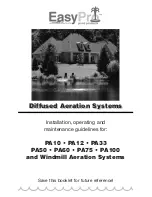
32
www. lochinvar .com
100221773_2000189439_Rev. 01
Venting instructions
1. Plan the venting layout starting at the vent termination
and work back toward the heater. Take into consideration
the style and position of the vent termination, the vent
pipe routing, elbows and connectors required and the
necessary support hangers.
2. Venting should be as direct as possible with the fewest
number of fittings. Use long radius 45 degree and long
radius 90 degree elbows wherever possible.
3. Avoid using 90 degree elbows “back to back” and
do not use street elbows. Maintain a minimum 6 in.
straight section between elbows. Closely coupled
and short radius elbows reduce the venting capacity.
Figure 31 shows examples of vent pipe connections.
4. DO NOT USE AN ELBOW AS A SUPPORT POINT.
Elbows are not designed to carry the weight of the
venting system.
5. Calculate “Equivalent Vent Length” before starting. Do
not exceed the values shown in Table 2. An example
of how this length is determined is shown in Figure 33.
The value from your calculations should also be used
to determine which rodent screen to install into the
vent termination elbow.
6. Measure the vent piping and cut to required lengths.
Pipes must be cut at right angles and deburred to
ensure a good smooth fit with sufficient overlap for
the glue joints. Correct any interference conditions.
7. Provide support hangers for horizontal vent piping
every 4 ft. to prevent sagging and stress. Provide
a minimum of 1/8 in. rise per 4 ft. of vent piping
to ensure adequate drainage (polypropylene vent
systems require a 1/4 in. rise per 1 ft. of vent pipe).
Horizontal vent piping must not sag to form valleys
where condensate can collect. Vertical venting shall
be supported every 5 ft. . Use appropriate support
straps and vibration isolators (foam pads) on straight
sections only. Allow sufficient clearance for expansion
and contraction of the venting system.
8. At the point where the venting exits the building, cut
a 3-1/2” hole for 3” venting or a 4-1/2” hole for 4”
venting. For sidewall applications, use the appropriate
metal cover plate as a template to mark the hole for
the vent pipe to pass through the wall. BEWARE OF
CONCEALED WIRING AND PIPING INSIDE THE
WALL.
9. Insert the vent piping through this hole and secure into
position. Connect the vent pipe to the end termination
elbow as shown in Figure 34 through Figure 36.
10. Dry fit all vent pipes, elbows, connectors and fittings
before joining any parts with solvent cement. PARTS
MUST FIT WITHOUT STRESS OR BENDING OF
ANY SECTION and each connection must overlap
a minimum of 1/2 in. . Do not force fit any of the
connections. Use only the appropriate solvent cement.
Caution:
Solvent cements may produce flammable
vapors. Use only in well-ventilated areas and keep
away from all sources of ignition.
Note:
DO NOT use solvent cement on polypropylene
vent systems.
11. Install the properly sized rodent screen into the outlet
elbow and secure with corrosion proof screws as
required. Refer to Figure 32 to determine the proper
screen.
12. Do not seal the vent piping to the wall until the venting
is properly connected to the blower assembly.
13. Complete the venting installation by sealing around
the termination assembly where it passes through
the outside wall, inside and out, with silicone or other
suitable sealant. Apply enough sealant to secure the
(optional) cover plate to the wall.
•
Use only in well-ventilated areas.
•
Do not use near flame or open fire.
•
Use only the Solvent Cement and Primer appropriate for
the venting material being used.
•
Solvent cements for plastic pipe are flammable liquids and
must be kept away from all sources of ignition.
Use of Solvent Cement and Primer
CAUTION
SEALANT
SEALANT
(UNDER
PLATE)
GROUND
LEVEL*
RODENT
SCREEN
(INSTALL
INTO
ELBOW)
* WHERE SNOW COVER IS NORMAL DURING
WINTER, ENSURE OUTLET IS INSTALLED
ABOVE ANTICIPATED SNOW LEVEL.
12 in.
MIN.*
ATTACH
TERMINATION
ELBOW (MAY
ALSO BE 90°)
6 in.
VENT PIPING MAY
BE SLOPED IN ANY
DIRECTION, AS
LONG AS A WATER
TRAP IS NOT
CREATED IN THE
VENTING SYSTEM.
THE SLOPE
SHOULD BE KEPT
TO A MINIMUM
SO AS NOT TO
EXERT ANY UNDUE
STRESS ON THE
PIPE.
COVER PLATE
(OPTIONAL)
Figure 34.
BRACKET
VENT
RISER
SEALANT
SEALANT
(UNDER
PLATE)
ATTACH
TERMINATION
ELBOW (MAY
ALSO BE 90°)
GROUND
LEVEL*
RODENT
SCREEN
(INSTALL
INTO
ELBOW)
VENT PIPING TO BE
SLOPED (DOWN)
TOWARD HEATER
TO PREVENT
WATER FROM
COLLECTING
(MAY REQUIRE
A CONDENSATE
TEE).
EQUIVALENT
VENT LENGTH
MEASURED
FROM THIS
POSITION
* WHERE SNOW COVER IS NORMAL DURING
WINTER, ENSURE OUTLET IS INSTALLED ABOVE
ANTICIPATED SNOW LEVEL.
12 in.
MIN.*
COVER PLATE
(OPTIONAL)
Figure 35.
















































